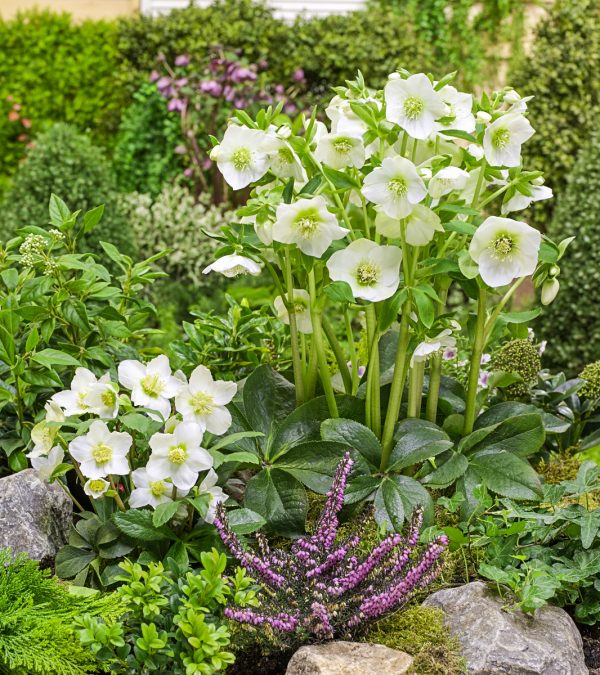How to Grow Spring Blooming Hellebore Flowers
Hellebores, oh hellebores, let me count the ways I love you!
As an avid shade gardener, I have collected hellebores for my home garden for over a decade, amassing dozens of specimens from every source I could find. I even had the deck in my backyard built around one-of-a-kind hellebores I couldn’t bear to see disturbed.
True story.
I. Want. Them. All.
What makes hellebores so wonderful?
Besides being indestructible, these plants offer four seasons of interest beginning with their late winter through spring blossoms and continuing with their broad umbrella-shaped, evergreen, leathery green foliage.
Hellebores are among the very earliest perennials to flower right along with your daffodils and tulips, continuing for six to eight weeks before they dry in place on the stems.
New foliage will sprout just as the flowers are finishing up, eventually enveloping the spent blossoms which will then deposit their seeds at the base of the plant. The evergreen foliage remains standing until the following spring when a new set of flowers and leaves take their place. It’s nature’s perfect process.
Grow your own bouquet
Picked hellebore blossoms can be enjoyed in two ways: floating and as a cut stem. I reserve a special glass bowl just for this purpose every spring. Floating hellebore blossoms last anywhere from a few days to over a week, depending on the age of the flower when you pick it. Cut stems last nearly as long, though you’ll want to re-trim the stems daily to extend their vase life.
Here’s what you’ll need to know to grow hellebores successfully.
- Sun – Hellebores are shade-loving plants that need a maximum of six hours of sunlight per day to thrive. They’ll be happier if planted where they receive morning sun rather than scorching afternoon rays.
- Water – Once they are rooted in, hellebores can handle dry shade like a champ. But for that first year when you plant them, keep the soil moist but not wet.
- Soil – Think of hellebores as woodland plants. They will grow best in humus-rich, loose soil that is well-drained and may struggle in heavy, wet clay. If you garden in clay soil, plant hellebores in amended soil in a higher part of your garden where water does not pool or grow them in containers. Slightly acidic to slightly alkaline soil pH is preferred.
- Hardiness – Most of the hellebores you’ll find at stores are Helleborus orientalis hybrids which are perennial in zones 4-9. Earlier blooming Christmas roses, Helleborus niger hybrids, are hardy in zones 3-8. Don’t worry if it snows on your hellebores. These super hardy plants love the cold!
- When to Plant – Hellebores are best planted during cool weather since they are actively growing at that time. Spring or fall will suffice, and if you live where winters are relatively mild, they can even be planted in winter.
- Feeding – Hellebores are the opposite of other perennials in that they do most of their growing when it is cold outside, especially in fall and spring. Consequently, you’ll want to feed them with a slow-release plant food formulated for perennials at this time instead of in the summer. Don’t be tempted to feed any other perennials in the fall while you’re out in the garden since, unlike your hellebores, they will be shutting down their growth for the season.
- Pruning – For purely aesthetic reasons, you will want to prune away last year’s tattered foliage sometime before the new flowers emerge in spring. Remove the entire leaf and stem, trimming them to ground level to make room for the new flowers and foliage that will emerge from the center of the plant in spring.
- Bloom Time – When you purchase a hellebore in spring, you may not see its flowers that first year. That could be because the plant is too young to produce flowers, or the plant may have bloomed already before you purchased it. Either way, your hellebores should flower beautifully the following year. It’s hard to wait, I know! Depending on which type of hellebore you are growing and how cold your climate is, it could bloom anytime from early winter through late spring.
The label that comes with the plant should indicate when you can expect to see blossoms. Hellebores need to experience freezing temperatures for about eight weeks in winter to be able to actively grow and bloom the following year, which is why they are not recommended for very warm climates.
4 of my favorite cultivars
Written By: Susan Martin, Gardener Sue News
For NGB Member: Breck’s
“This post is provided as an educational/inspirational service of the National Garden Bureau and our members. Please credit and link to National Garden Bureau and author member when using all or parts of this article.”











